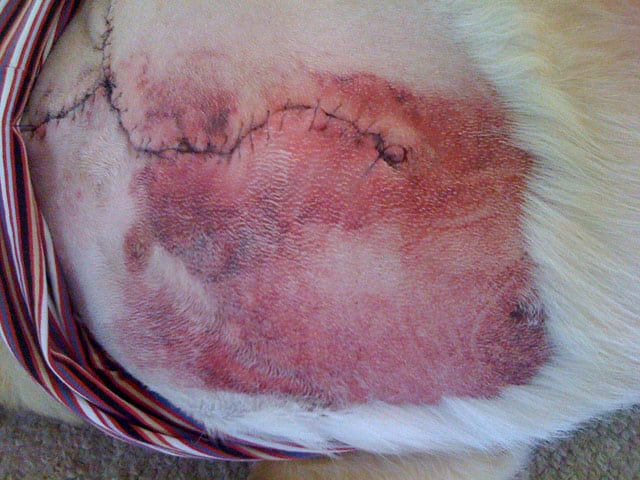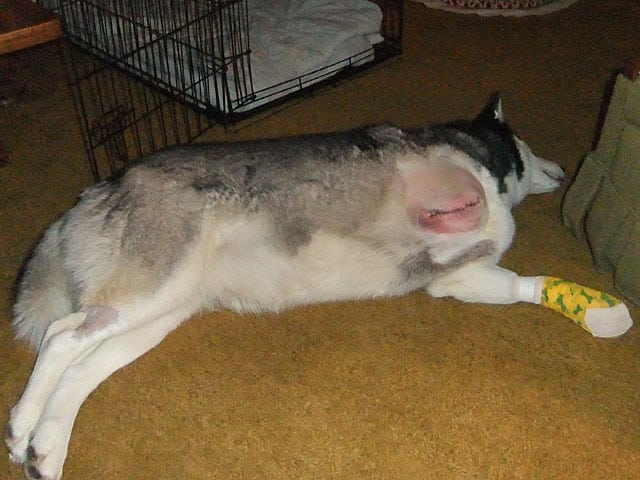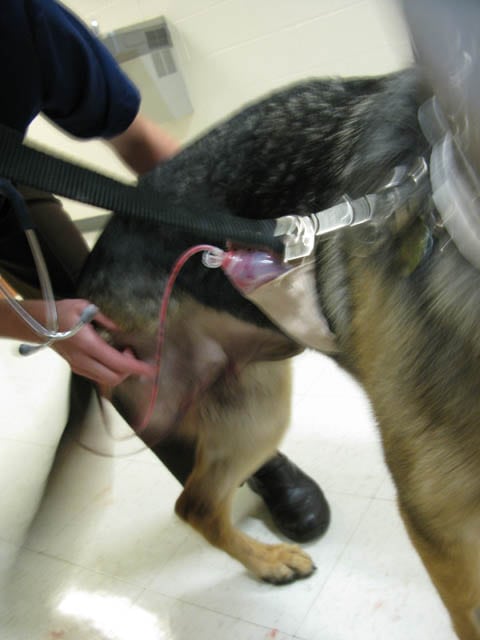Caring for a Three Legged Dog or Cat
Tripawds is your home to learn how to care for a three legged dog or cat, with answers about dog leg amputation, and cat amputation recovery from many years of member experiences.
Join The Tripawds Community
Learn how to help three legged dogs and cats in the forums below. Browse and search as a guest or register for free and get full member benefits:
Instant post approval.
Private messages to members.
Subscribe to favorite topics.
Live Chat and much more!
Caring for your dog's amputation incision is usually as easy as ensuring that nature is taking its course and healing the site.
 Most dogs like Tripawds Founder Spirit Jerry have minimal problems at the wound, but unfortunately some dogs like Tripawds Spokesdawg Wyatt Ray and Valentina the Great Dane experience surgical wound complications, such as continuous serum (blood and bodily fluids) leakage that requires extended veterinary care and longer recuperation times.
Most dogs like Tripawds Founder Spirit Jerry have minimal problems at the wound, but unfortunately some dogs like Tripawds Spokesdawg Wyatt Ray and Valentina the Great Dane experience surgical wound complications, such as continuous serum (blood and bodily fluids) leakage that requires extended veterinary care and longer recuperation times.
If you're about to start your Tripawd journey, take time to be prepared for wound complications, just in case.
Here's a quick rundown of some things to keep in mind:
Keep a Post-Amputation First Aid Kit Handy
Your vet may want you to change bandages or clean around the incision. Be prepared by stocking a pre-made pet first aid kit or making one yourself. To care for amputation wounds, your kit needs:
Muzzle
- Sterile gauze pads, large
- Scissors
- Surgical scrub solution
- Small towels
- Flexible vet wrap
- Digital thermometer
- Cold and hot pack
- Gloves
- Flexible, strong adhesive tape
- Rescue Remedy holistic calming aid (for both you and your Tripawd!)
To Bandage or Not to Bandage?
 Your dog may or may not come home with a bandage over the incision, or a drain.
Your dog may or may not come home with a bandage over the incision, or a drain.
Our Tripawds Amputation Survey shows that more dogs come home without a bandage and drain, but it's up to you and the vet to determine if these things are necessary. Most times they aren't; usually it seems that a bandage is applied to lessen the shock value when pawrents see the wound for the first time.
Wound Drains
 We never had firsthand experience with a "Jackson Pratt" or JP drain until our Wyatt came home from surgery last week. Had we known he was getting one, we might have asked about whether or not it was necessary, since ultimately it clogged and didn't release any of the fluid that was building up.
We never had firsthand experience with a "Jackson Pratt" or JP drain until our Wyatt came home from surgery last week. Had we known he was getting one, we might have asked about whether or not it was necessary, since ultimately it clogged and didn't release any of the fluid that was building up.
JP Drains
One end of the drain tube is inserted into an incision near the surgical site to help release fluid accumulation. To the other end is attached a bulb that is compressed to create negative pressure, causing suction of fluid from the wound.
As a pawrent, your only responsibility is to empty the bulb when it looks full. Your vet will supply you with large syringes to measure the fluid amount.
The JP drain's interior needs to be kept sterile: do not use water to rinse the bulb or tube, simply replace the bulb after emptying the fluid. Be sure to squeeze it before sealing it closed to reactivate its suction.
After JP drain removal:
 Wyatt's JP drain was removed four days after surgery. The drain's bulb never filled up, so we and the vet assumed there was no drainage occurring. We were wrong. Almost immediately after removing the drain, Wyatt leaked copious amounts of serum in the vet's office. Clearly, the drain had clogged somewhere and was holding back tons of fluid.
Wyatt's JP drain was removed four days after surgery. The drain's bulb never filled up, so we and the vet assumed there was no drainage occurring. We were wrong. Almost immediately after removing the drain, Wyatt leaked copious amounts of serum in the vet's office. Clearly, the drain had clogged somewhere and was holding back tons of fluid.
To help the area drain but prevent infection at the drain site, Wyatt's vet sewed a series of loops around the drain site in order to hold a large stack of gauze over the hole. As an area that's difficult to bandage, he thought that keeping the gauze in place with the loops and surgical tape would work.
Unfortunately we didn't have time to take a photo of this impromptu experiment since it fell off almost immediately after leaving the hospital. The gauze was too full with the weight of the fluid to stay in place. A taped-on bandage was more effective. Using a low-tack adhesive tape is recommended, however, to avoid painful removal when changing the dressing.
Incision Healing Progress
Without complications, the amputation incision site will heal within 10-14 days. A permanent scar forms between 14-21 days.
Bruising and redness is normal after surgery, but to a point. Excessive redness and irritation can be a sign of something else going on, usually just an infection that can be cleared up with antibiotics.
This great article at PetPlace.com, Is My Dog's Incision Healing Normally? offers terrific insight into how a wound develops, heals and what to watch out for, such as:
- Foul smelling discharge: Tell your vet about any discharge that isn't clear and odorless.
- Excessive fluid drainage: Some dogs will get a seroma, which is a combination of blood and bodily fluid buildup at the incision site. Seromas usually aren't serious and can be drained in a vet's office, but you need to tell your vet your dog is having one to make sure it's not more serious. You can try to prevent a seroma by keeping your dog calm for at least a week after amputation: too much activity can ramp up the immune system and lead to excess fluid buildup.
- Missing stitches or staples: If sutures fall out, this can indicate infection and an inability for the skin to heal. Also, if you see a wide gap (larger than ¼ inch) between the wound or tissue sticking out from the wound, call your vet immediately.
Whatever you do, DO NOT clean the wound with anything that your vet hasn't prescribed. Do not use hydrogen peroxide on the incision, it can kill the cells trying to heal causing further complications. If the wound area gets soiled, use warm water only to clean around the incision and ask your vet what you should to do if further cleaning is necessary.
Itchy Wounds
Stitches are usually removed 10-12 days after surgery. After removal, most dogs go crazy trying to soothe the incision area as it dries and becomes more itchy. Unfortunately the cone of shame is the only surefire way to prevent your dog from damaging the wound.
In our ebook, "Three Legs and a Spare – The Tripawds Canine Amputation Handboook", we share tips for preventing your dog from bothering the incision, such as:
- Use a Bath Towel: Loosely secure a large rolled towel around your dog’s neck (not too loose that she can slip away). The thick towel can serve as a barrier between her neck/chin and the incision.

A special sock like Power Paws Traction Socks for Dogs or dog boots like Ruff Wear’s Grip Trex and Skyliner can be used to keep your dog’s paws from scratching at the site, but dogs with degenerative mobility issues should not use them.
- Use of an anti-inflammatory spray such as DermaCool HC.
- Over the counter medicines to relieve itching, such as Benadryl and Chlorpheniramine
- Some vets recommend using ointment such as Neosporin. Others suggest using nothing that may prohibit natural healing of the incision.
- Homeopathic remedies suggested in The Whole Pet Diet, include Calendula, Comfrey and Myrh which all have antiseptic and healing properties.
We hope these tips will help as you care for your three legged dog's amputation wound. If you are having any post-op complications, please call your vet and then join in the Discussion Forums for a shoulder to lean on from Tripawds pawrents who've been there.
Recommended Reading:
Tripawds Gear Blog: Cone of Shame Alternatives
One Vet’s Canine Amputation Surgery and Recovery Tips
Post-Amputation Side Effects in Dogs
Amputation Surgery Suture Reaction in Dogs
DISCLAIMER: Information provided is not a substitute for professional veterinary advice. Please consult your vet with any concerns. Always follow the direction of a licensed veterinarian prior to making any medical decisions about your dog’s health.
Tripawds Founders Jim and Rene
tripawds.com | tripawds.org | bemoredog.net | triday.pet
This is such a great post, very informative! Brandy had a horrible recovery that included infection after infection. We believe the original problem started with the stapes being placed too far apart. From day one, the staples always had small gaps in between them. Brandy also lost so much weight due to her not wanting to eat after the amputation so that caused a lot of issues also because of the loose skin. I would inform my vet to go overboard with the staples if you have a large dog that may be a little overweight before the surgury. We were to blame for not keeping the cone on her once things started to heal. DO NOT feel bad about leaving your dog in the cone or putting ridiculous socks on them or making them where a T-shirt. Two weeks of this is better than 2 months of trips to the vet, all the extra healing time and expense of added care...not to mention the pain and discomfort the poor dog has to go thru. Make sure you monitor the site a few times a day and inform your vet of ANY changes immediately!
My dog had his amputation 16 days ago and is healing very well. We had stitches taken out on post-op day 14 and had some trouble getting them out. They were so scabbed over. Since some scabs came off during suture removal, I've been treating the wound with an antibiotic-steroid-antiseptic powder 2-3 times a day for the past couple of days. A friend of mine has suggested putting vitamin E on the wound to minimize scarring. I'm not sure when or if I should do this. There is still some scabbing on parts of the incision and I do not want to complicate things. Should I wait until scabbing is gone or can I start applying it now? Or should I just not use it at all? All in all, we've experienced an amazing recovery. He's had to wear the cone of shame and a t-shirt to protect the incision and he's tolerated both very well. Thanks so much to anyone who can help answer this question!
Your instincts are right, I would not apply vitamin E at all. That might work for humans but we were told by a vet recently to keep things as minimal as possible at the incision.
Wear that amputation scar like a battle scar and wear it proud. He is a true warrior.
Good luck!
Tripawds Founders Jim and Rene
tripawds.com | tripawds.org | bemoredog.net | triday.pet
Very informative, just what I needed! Katy's 4 days post-op and already getting itchy, between the wound healing and hair regrowth. We've got her in a T shirt, but her nails are pretty thick and I just worry she'll nick the incision (she doesn't bite at it, just scratch with her hind leg). Fortunately we've got her under very close supervision and she's sleeping most of the time anyway. I was planning on doing away with T shirts once her stitches came out, but I guess we'll just have to see how itchy she gets.
I'm Crystal, but you can call me Katymom. :) I'm Triproud of my Tripawd!
Katy Sue Sarcopski – born approx 2/03, found "the lump" 9/7/11, suspected soft tissue sarcoma (most likely liposarcoma) 10/11, became a Tripawd 11/1/11, official diagnosis of infiltrating lipoma 11/23/11
Follow her "tail" at katydidit.tripawds.com!
1 Guest(s)

 Register
Register Log In
Log In Members
Members

 Read the original blog post
Read the original blog post Add Reply
Add Reply Add Topic
Add Topic Offline
Offline










